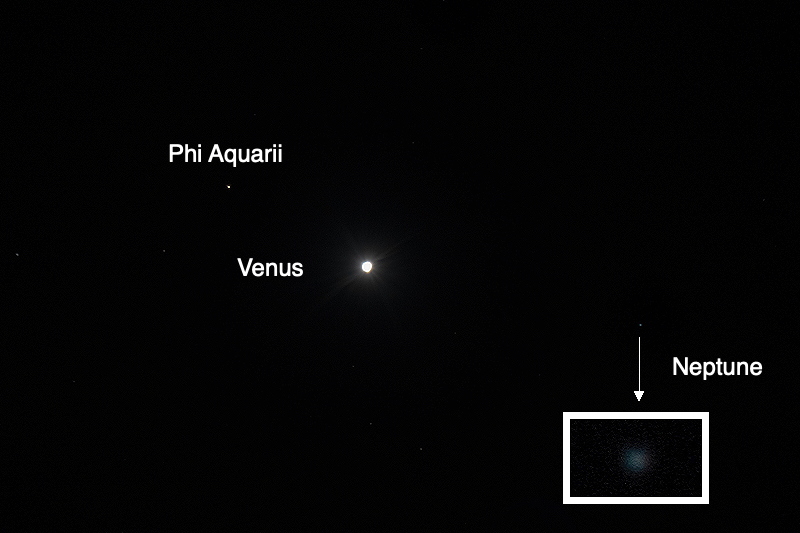Venus Neptune Conjunction,
Comet C/2017 T2 (PanSTARRS) and Double Cluster
Posted: 28 January 2020
|
Open: Monday, 27 January 2020, 1806 MST Temperature: 63°F |
Session: 1429 Conditions: Mostly clear |
Equipment:
12" f/8 LX600 w/StarLock
2" 24mm UWA eyepiece
2" 2X PowerMate
SkyTracker Pro
Camera:
iPhone 11 Pro Max
D850 DSLR
After opening the observatory I stepped back outside for this iPhone 11 Pro Max photo of the observatory and the crescent Moon and planet Venus.

1819 MST: LX600 ON, StarLock OFF, High Precision OFF.
Viewed the Moon, 102X.
1823 MST: viewed the close conjunction (18') of the planets Venus and Neptune, 102X. It was neat to see both planets in the same eyepiece field-of-view.
1839 MST: clouds were approaching from the west when I took this handheld D850 DSLR photo (f/5.3, 1/20sec, ISO 1600, FL 220mm) of the Moon with Earthshine through some thin clouds, and the planet Venus near the star Phi Aquarii (top).

Mounted the D850 DSLR at prime focus of the 12" telescope and took these photos of the Moon (1/250sec, ISO 640) and Earthshine (1 second, ISO 640).


I slewed to Venus and took this prime focus D850 DSLR photo of the 18' conjunction of Venus and Neptune (1/4sec, ISO 1600). The inset shows a magnified view of Neptune. Venus was overexposed in order to show Neptune, but a hint of the gibbous phase of Venus is detectable.

1909 MST: took another look at Venus and Neptune, 102X.
1920 MST: viewed NGC7662 (Blue Snowball Nebula, planetary nebula), 102X and 203X.
I then began monitoring the cloud situation to see if I was going to be able to image the Blue Snowball using the Optolong SHO filters. The clouds looked like they might also interfere with imaging Comet C/2017 T2 (PanSTARRS) near the Double Cluster, which I had planned for later in the session.
1938 MST: cloud cover was increasing and the satellite image showed more clouds on the way. I decided to cancel the Blue Snowball imaging and set up to image the comet. Mounted the D850 DSLR with a 150-600mm lens on the SkyTracker Pro. Unlike the failed attempt on the previous session, this night I turned the lens Vibration Reduction OFF. Did a quick polar alignment of the SkyTracker Pro. Using the ScopeStuff Red Dot Finder for SLR Hotshoe I aimed the camera at the Double Cluster. I took several photos of the comet and the Double Cluster using various exposure durations and ISO settings and at focal lengths of 150mm and 600mm. At FL 600mm I was not able to use exposures longer than 30 seconds. But as the clouds were approaching I decided to not try to improve the polar alignment. Fortunately, the D850 DSLR handles very high ISO settings very well. This first image (f/5, 30 seconds, ISO 25600, White Balance 5560K, FL 150mm) is a wide field view showing the Double Cluster with Comet C/2017 T2 (PanSTARRS) near it. At the right side are the Heart and Soul Nebulae.

Mouseover or tap on image for labels
This image (f/6.3, 30 seconds, ISO 25600, WB 5560K, FL 600mm) of the Double Cluster shows the small faint comet about 4 o'clock to the two star clusters.

2017 MST: with the comet imaging completed I took this iPhone photo of the setup.

2025 MST: LX600 OFF.
Did not take any Sky Quality reading this night due to the cloudy sky.
|
Close: Monday, 27 January 2020, 2040 MST Temperature: 46°F |
Session Length: 2h 34m Conditions: Mostly cloudy |
The Edmund Scientific Telescopes Memorial Page has been updated.
Comments are welcome using Email. Twitter users can use the button below to tweet this report to their followers. Thanks.
Cassiopeia Observatory Home Page
Copyright ©2020 Michael L. Weasner / mweasner@me.com
URL = http://www.weasner.com/co/Reports/2020/01/28/index.html
